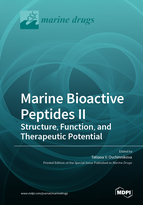Marine Bioactive Peptides II: Structure, Function, and Therapeutic Potential
A special issue of Marine Drugs (ISSN 1660-3397).
Deadline for manuscript submissions: closed (31 May 2021) | Viewed by 44214
Special Issue Editor
Interests: marine natural products; marine peptides; innate immunity; host defense peptides; molecular mechanisms of antimicrobial and anticancer activity; structure elucidation; structure-function relationship; bioengineering; drug design; peptide antibiotics; peptide anticancer agents; drug resistance; bioorganic chemistry; biotechnology
Special Issues, Collections and Topics in MDPI journals
Special Issue Information
Dear Colleagues,
This second edition of the Special Issue “Marine Bioactive Peptides: Structure, Function, and Therapeutic Potential” aims to collect papers on up-to-date information regarding isolation, structural elucidation, functional characterization, and therapeutic potential evaluation of peptides isolated from marine organisms. Chemical synthesis and biotechnological production of marine peptides and their mimetics will also be a focus of this Special Issue. In addition, this Special Issue will publish new results arising from a peptidomic approach.
Marine peptides that are diverse in structure and function have been found in various phyla, and their number has dynamically grown in recent years. Some of them are evolutionary ancient molecular factors of innate immunity that play a key role in host defense. A plethora of biological activities, including antibacterial, antifungal, antiviral, cytotoxic, neurotoxic, anticoagulant, antifreeze, endotoxin-binding, and immune-modulating, make marine peptides an attractive molecular basis for the design of innovative antibiotics, anticancer drugs, analgetics, medicines for neurological disorders, etc.
24 Papers were accepted and included in the first issue, which we published as a Special Issue book (https://www.mdpi.com/books/pdfview/book/1742). Following the success of the first Special Issue, as Guest Editor, I invite researchers in the field to contribute to the second edition entitled "Marine Bioactive Peptides II: Structure, Function, and Therapeutic Potential".
Prof. Dr. Tatiana V. Ovchinnikova
Guest Editor
Manuscript Submission Information
Manuscripts should be submitted online at www.mdpi.com by registering and logging in to this website. Once you are registered, click here to go to the submission form. Manuscripts can be submitted until the deadline. All submissions that pass pre-check are peer-reviewed. Accepted papers will be published continuously in the journal (as soon as accepted) and will be listed together on the special issue website. Research articles, review articles as well as short communications are invited. For planned papers, a title and short abstract (about 100 words) can be sent to the Editorial Office for announcement on this website.
Submitted manuscripts should not have been published previously, nor be under consideration for publication elsewhere (except conference proceedings papers). All manuscripts are thoroughly refereed through a single-blind peer-review process. A guide for authors and other relevant information for submission of manuscripts is available on the Instructions for Authors page. Marine Drugs is an international peer-reviewed open access monthly journal published by MDPI.
Please visit the Instructions for Authors page before submitting a manuscript. The Article Processing Charge (APC) for publication in this open access journal is 2900 CHF (Swiss Francs). Submitted papers should be well formatted and use good English. Authors may use MDPI's English editing service prior to publication or during author revisions.
Keywords
- marine peptides
- structure
- function
- chemical synthesis
- biotechnological production
- peptidomics
- therapeutic potential
- antibacterial
- antifungal
- antiviral
- cytotoxic
- neurotoxic
- anticancer
- anticoagulant
- endotoxin-binding
- host defense
- innate immunity
- toxins
- peptide drugs
Related Special Issues
- Marine Bioactive Peptides: Structure, Function, and Therapeutic Potential in Marine Drugs (25 articles)
- The Pharmacological Potential of Marine-Derived Peptides and Proteins in Marine Drugs (12 articles)
- Marine Proteins and Peptides in Marine Drugs (27 articles)
- Marine Peptides and Their Mimetics in Marine Drugs (26 articles)
- Marine Bioactive Peptides: Structure, Function, and Therapeutic Potential - III in Marine Drugs (8 articles)
- Marine Bioactive Peptides: Structure, Function, and Therapeutic Potential IV in Marine Drugs (6 articles)







